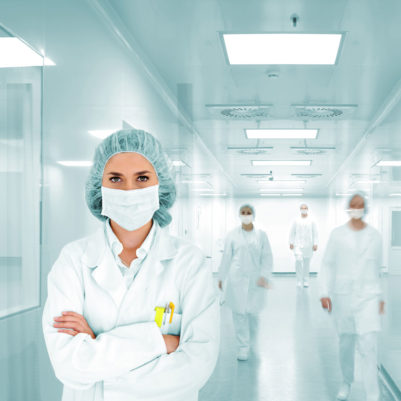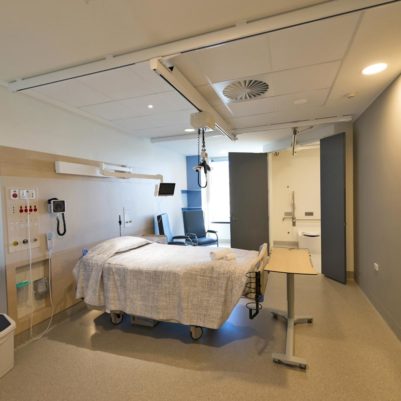How to light a hospital
Profound effect
The effects of lighting on health and productivity are brought into sharp focus in our hospitals. A well-designed lighting system not only ensures that all tasks in different areas are carried out effectively but also has a positive effect on the emotions and general well-being of patients.
The quality of light affects patient outcomes, safety and satisfaction while having an impact on how staff work, their morale and on both recruitment and retention. Getting the balance right is all-important in a modern, efficient medical facility.
Lighting design will take into account the positioning, availability and management of natural illumination to ensure that the health benefits are optimised while excessive heat and visual problems are minimised.


In provision of artificial light, there is a balance to be struck between the patients’ needs and those of the staff. Lighting should provide be bright and adaptive settings while avoiding glare but offer good visibility for hospital professionals. The deployment of full-spectrum lighting with a full-spectral wavelength that mirrors natural light and has good colour rendering is recommended.
At the same time, financial considerations will impact on lighting choices. Initial costs of first-fit or retrofit together with energy consumption and maintenance all feed into the decisions. And LED lighting is a clear winner in all these respects.
First impressions
The busy hospital environment is experienced in different ways by the many and varied numbers of people using its services, from the patients and medical professionals to the families and friends and non-clinical staff.
First encounters with the hospital environment are usually the grounds and car-parking so it’s very important to ensure the lighting is effective and inviting. It is clearly paramount to ensure that dark and unevenly lit exterior spaces, bad for security as well as hazardous, are avoided. Well-designed lighting gives visitors a sense of security and is welcoming while having a positive effect on both patients and staff. Effective LED car park lighting, for example, provides high levels of illuination together with low maintenance and big energy savings.
Reduce stress
Well-designed illumination also should reduce the stress of navigating the unfamiliar hospital environment for both visitors and patients. It’s a big challenge that needs to be effectively addressed.
Once inside the medical facility, it’s important that patients and visitors experience the best quality of light possible, from the reception areas to waiting rooms and corridors. By using a smart lighting solution, illumination levels can be optimally adjusted throughout the day and night which helps to healthily maintain body rhythms even where there is no natural light.
More hospitals across the country and abroad are choosing to upgrade to LED lighting as there is clear evidence that is has a positive impact, both clinically and financially.


Getting the spec right
The lighting designer will take into account luminous intensity, luminance, luminous flux and illuminance when specifying LED upgrades to provide the best conditions across the varied areas in the hospital environment.
In the surgical and care areas there is a wide remit for lighting specification. For example, in the reception and waiting or day rooms, the aim would be for a relaxing atmosphere provided by lighting that provides 200 lux and a colour rendition of 80. In the corridors, lighting controls would ensure that there is a daytime lighting level of 200 lux, dropping to 50 at night, with an 80 colour render.
In general clinical areas, the aim would be to provide 300 lux and 80 colour render, while examination rooms need higher levels of 500-1000 lux and 90 colour render.
In patient rooms and wards by contrast, the need would be for general lighting levels of 100 lux and 80 colour render with controls to boost lux levels to 300 for reading purposes, and in the bathrooms and toilets, 200 lux and 80 colour render would be effective.
While daylight offers a beneficial full spectrum of colours there is much variation, taking into account seasons, meteorological conditions and latitude. There are LED solutions that now offer full-spectrum light and studies indicate that daylight is not inherently superior to artificial lighting for performance of most visual tasks.
Studies also show that better quality light levels are linked to reduced dispensing errors in pharmacies. Effective lighting can also affect performance and stress levels in operating theatres. Studies indicate that low-light conditions increase the difficulties in decision making and care provision by night staff. Top quality lighting levels are essential, given that older medical staff need up to three times as much light as a 25-year-old colleague.


Everything’s better with LED
Poor quality light is responsible for challenging situations where visual discomfort leads to difficulty in completing tasks, adds levels of confusion and is a cause of distraction.
The deployment of well-designed LED lighting helps to reduce or remove the negative areas that can cause errors and inefficiencies while at the same time achieving considerable cost savings through reduced energy consumption and drastically lower maintenance. Storage provision is also reduced as LEDs have a very long working life, so fewer lamps and bulbs are needed in stock.
With energy savings of up to 85%, the return on investment with LED is rapid and quality of light much improved. At the same time, it can bolster medical staff performance along with job satisfaction, while helping to improve patient experience and recovery times.
The “always-on” nature of the hospital environment demands that lighting is efficient and highly effective, and an LED solution with smart controls ensures that every setting is responsive to the needs of patients and staff.
And from medical staff to maintenance/cleaning and office support, the provision of quality LED lighting helps to promote greater efficiency and have a positive impact on costs.